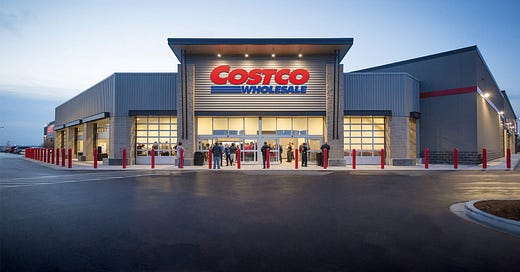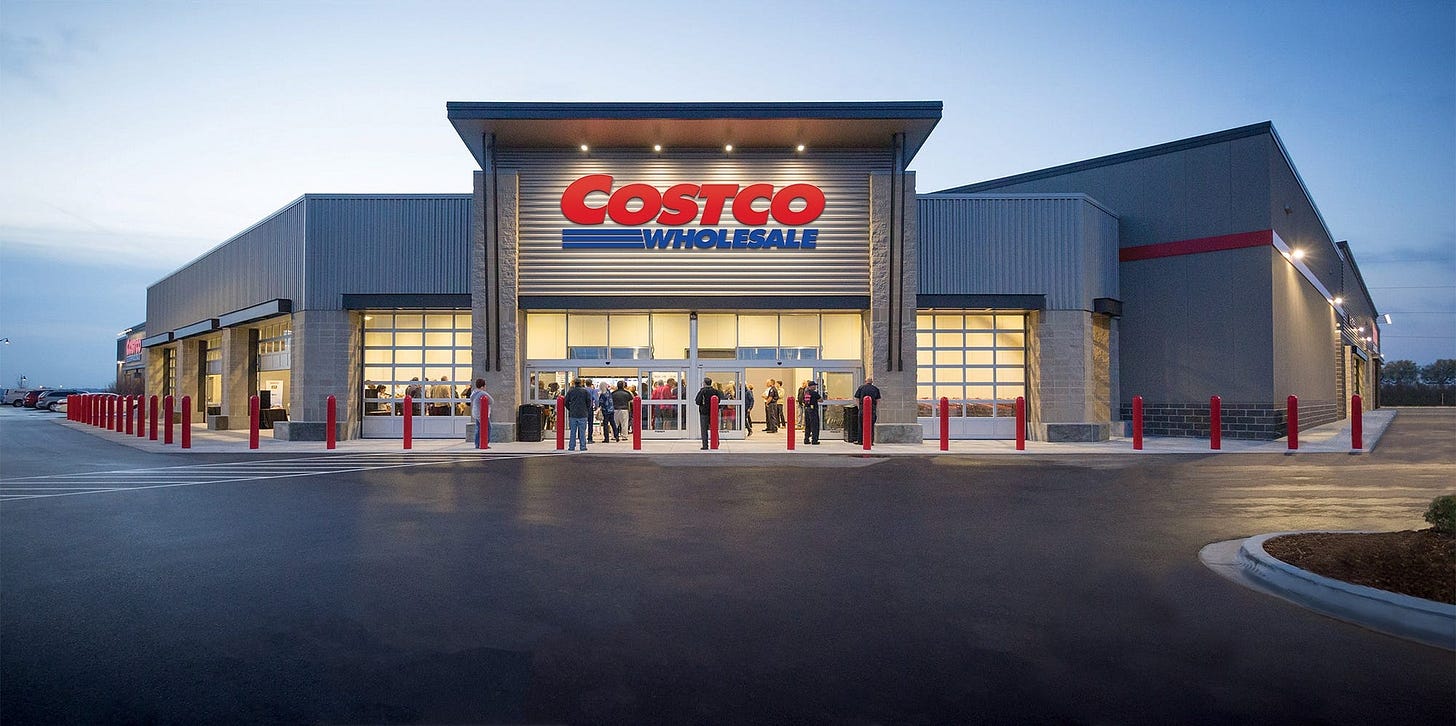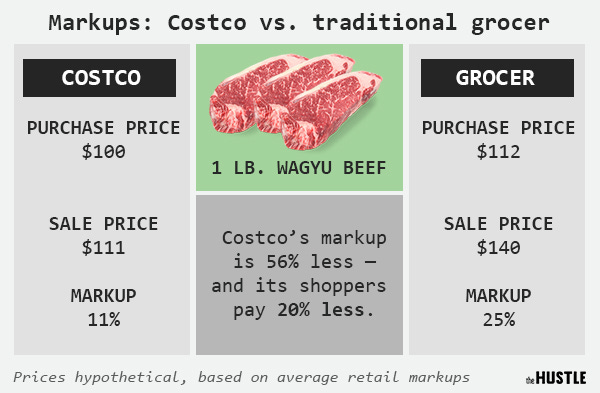Costco and other warehouse stores are the one-stop shop for healthy fuel. Here's a grocery list, plus meal ideas for how to best use the store's lower-priced, high-quality ingredients.
Housekeeping:
Scarcity Brain made the New York Times Bestseller list thanks to you all. Thank you for the immense support of the project, and I hope you enjoyed the book.
This post, like all Monday posts, is free. Wednesday and Friday posts are for Members only. Become a Member below.
Don’t want to pay for a Membership? Recommend 2%. Refer a few friends and get a free Membership to 2%.
Now let’s get on with it …
My new book, Scarcity Brain, contains the following sentence:
To supplement my diet, I drove to Costco, a place that, along with democracy, I consider one of America’s great institutions.
I meant that.
Because the 2% project publishes three times weekly, we can get more tactical—we can analyze hyper-specific ways to live better every day. We can go down niche, but useful rabbit holes I don’t go down in my books due to the pacing of books.
We often think eating healthy costs more money and takes more time. That can be true—but only if you’re shopping in the wrong places.
Today we’re going down a Costco rabbit hole. It’s a place that can help you:
Eat healthier.
Save money.
Save time.
Of course, if you’re more of a BJ’s or Sam’s Club person, that’s cool too. Costco is the GOAT warehouse store (for reasons you’ll learn below), but this story applies to all warehouse stores.
Let’s dive in.
The Case for Costco
In short
Costco is a favorite of nutritionists and certified financial planners.
The details
Costco is a place where you can purchase everything from gasoline to fitness equipment to TVs to all sorts of delicious healthy calories—in bulk, for less money, without sacrificing quality.
Heck, you can even buy a casket, a relaxing trip to a luxury resort pretty much anywhere in the world, a Cadillac, a 72-pound wheel of Parmesan cheese, or a 27-pound bucket of Mac & Cheese, which, paired with the 72-pound cheese wheel, should give you enough cheesy calories to ride out the zombie apocalypse (not if, but when…).
I first started talking about the wonders of Costco with my aunt Rachele. This was when I was in my early 20s and becoming a human who tries to eat healthily but also finds the prices at Whole Foods to be an affront to decency.
Turns out Rachele is the perfect person to speak to about feeding yourself and your family healthily and cost-effectively.
Rachele is a Utah-based nutritionist who works with clients ranging from tech execs to professional outdoor athletes (she works by word of mouth only, so holler if you want an intro). She also raised four kids, two of whom eat more food than anyone.
What’s essential for this topic—the “Costco saves you money” part of it—is that Rachele is married to my uncle, who works in finance and is a brilliant mind in personal finance. He’s the type of person who might run a spreadsheet on the price per pound of various fruits and vegetables at different grocers within a 25-mile radius of his home to get a bargain (while, of course, also factoring time, gas, and more into the equation of where to buy).
“I actually give my clients a Costco shopping list,” Rachele told me. “There are so many healthy, economical options. It just makes it easy and affordable for people to eat healthy.”
Two Reasons Why Costco Rules
In short
Costco has engineered itself differently than other retailers to save customers time and money.
The details
1. It saves you money
Costco’s founder, Jim Sinegal, once famously said, “If (saving the customer money) doesn’t turn you on, you’re in the wrong business.”
And, well, let’s just say the man has executed on his fetish.
As the New York Times reported in an article called “How Costco Became the Anti-Walmart”:
At Costco, one of Mr. Sinegal's cardinal rules is that no branded item can be marked up by more than 14 percent, and no private-label item by more than 15 percent. In contrast, supermarkets generally mark up merchandise by 25 percent, and department stores by 50 percent or more.
Costco buys items in giant quantities, allowing them to purchase them cheaper from the manufacturer. Here’s a fun graphic from The Hustle, explaining how the combination of Costco’s ability to buy its products for less and then sell them to you at a lower markup saves you money:
This approach applies to everything inside Costco.
Costco’s shelves hold all sorts of items sold for a fraction of the price you’d pay at a typical grocery store. To take three random examples you can buy:
The best Saigon cinnamon you’ll ever taste: 11 ounces for $2.50 vs. 4.79 for 1 ounce at Whole Foods.
Mass quantities of organic chia seeds: two pounds for $7.50 vs $15.99 for one pound at Whole Foods.
Gigantic jugs of pure, organic maple syrup: 33 oz for $11, versus $26 for the same quantity at Whole Foods.
And on, and on, and on down the aisles.
Costco’s in-house brand, labeled Kirkland Signature, offers the best deals.
Most in-house brands are of lower quality. But Kirkland Signature products are produced by some of the country’s most well-known food makers but sold for less.
For example, Starbucks roasts Kirkland coffee (two pounds, $10), Bumble Bee produces the Kirkland Signature albacore tuna (eight cans, $13), and Adams does Costco’s organic peanut butter (56 ounces, $10).
And Costco is savage about its prices. It even goes as far as working with manufacturers to reengineer products to be cheaper.
For example, this CNBC documentary explains how Costco wanted to carry a specific toy that the manufacturer was selling at wholesale for $50, meaning that Costco would sell it for just under $60.
Costco worked with the toy company to optimize how they manufactured the toy and shaved 50% off the wholesale price. The result: Costco could sell the same toy to its customers for $30. As the Hustle explained:
The profit margin Costco made from the toy at $30 was the same it would’ve made at ~$60: The time and resources the company invested to lower the price were strictly for the benefit of their shoppers.
So how does Costco make money? Membership fees. A standard annual Costco membership runs $60.
If you do most of your shopping there, you’ll make that up in no time. My uncle, the financial mind, swears by the value of Costco.—Even if you’re single or living in a two-person home.
“For example,” he said. “Even though you have to buy a massive three-pound bag of organic spinach if you want spinach, it’s only $5. That’s way more economical than buying a one-pound bag for $4 at the regular grocery store.”
Worried you won’t eat bulk items in time? Freeze them.
2. It saves you time
Costco saves you time in two ways.
When you buy in bulk, you come home with more, meaning you make fewer trips to the store.
Costco makes your decisions for you.
The average grocery store stocks 40,000 to 50,000 items.
The average Costco warehouse, on the other hand, has an average of 3,700 items.
This is because Costco sells just one or two versions of a given food or product. This is a feature, not a bug.
Instead of offering you, say, 27 different types of plant milks, eggs, bags of rice, or energy bars, Costco buyers do rigorous testing and select what they consider to be one to three of the best takes on the product and offer only those at a competitive price.
This saves you money (it takes more financial resources to carry more products, costs that get passed onto the consumer), and it cuts down on decision fatigue.
Another benefit: “Costco’s food is usually much fresher than the grocery store’s,” Rachele said. The combination of lots of customers and fewer choices means that Costco turns over its food supply much quicker than an average store.
What to buy
If you’re a new (or soon-to-be) Costco membership holder, Rachele’s client food list below will help you get your bearings. It focuses primarily on single-ingredient foods, which a recent study found can help you lose weight no matter how you approach your diet.
(P.S. Read Scarcity Brain to learn more about the power of single-ingredient foods.)
Here are the list’s highlights—don’t worry, you don’t have to buy them all at once—and a few examples showing how you could put them together:
Fruits and Vegetables
Organic spinach or baby kale
Baby carrots
Frozen mango chunks
Organic lemons
Sugar snap peas
Frozen berry mix
Romaine lettuce
Yams/Sweet Potatoes
Avocados
Dried figs (great for endurance athletes)
Bananas
Broccoli
Meats
Ground organic turkey
Wild-caught frozen salmon burgers
Boneless skinless frozen chicken breast
Rotisserie chicken
Dairy
Almond or coconut milk—unsweetened
Kirkland 0% fat plain Greek yogurt
Carbs
Quinoa
Rice noodle ramen
Lundburg’s organic short-grain brown rice
Oatmeal
Lentils
Banza rotini made from Chickpeas
Veggie Craft Farms Penne
Snacks, etc.
Raw almonds
Raw Brazil nuts
Hummus
RX Bars
Nuttzo nut butter
Simple almond flour crackers, Harvest Stone organic quinoa crackers
Kirkland protein bar—great protein and a treat
Hemp seeds
A Quick Breakfast
Blend the following:
Spinach (frozen)
One Banana (frozen)
One scoop Momentous Essential Plant Protein (not a Costco item, but Costco does sell protein powders)
1.5 cups unsweetened almond milk
1 serving Kirkland 0% Fat Greek Yogurt
1 serving Kirkland frozen berry mix
1/2 serving raw almonds and/or Hemp seeds
A Quick Lunch
Make a salad that includes the following:
Baby kale or spinach
Carrots
Snap peas
Broccoli
1 chopped wild-caught salmon burger
1 cup cooked Lentils
1 serving light dressing
A Quick Dinner
Make a one-pan meal featuring:
Quinoa, riced cauliflower, or sautéed yams
Chicken breast or rotisserie chicken
As many vegetables on the list as you like
Quick Snacks
Dried figs and protein shake
Nut butter with a banana
RX or protein bar
Crackers and hummus and/or rotisserie chicken
Have fun, don’t die, God bless America, democracy, and Costco.
-Michael
Sponsored by Maui Nui Venison
Axis Deer provides the healthiest meat on the planet. That's according to researchers at Utah State, who compared axis deer meat to beef and found that it contains 1 to 64 times more antioxidants, vitamins, minerals, and healthy fats. It also contains 53% more protein per calorie than beef. Here's a fascinating brief on the research. Equally important is that Maui Nui solves ethical considerations around meat. Axis Deer are an invasive species ravaging the Hawaiian island of Maui, and Maui Nui harvests the deer at night in a stress-free way, improving the ecosystem.
My picks: I like it and eat everything from Maui Nui, but the 90/10 Organ Blend is particularly great for people looking to get more micronutrients in their diet, and the Jerky Sticks are my go-to travel snack.
**Use discount code EASTER for 15% off.**
Sponsored by GORUCK
When I decided to accept sponsorships for this newsletter, GORUCK was a natural fit. Not only is the company's story included in The Comfort Crisis, but I've been using GORUCK's gear since the brand was founded. Seriously. They've been around ~12 years and I still regularly use a pack of theirs that is 11 years old. Their gear is made in the USA by former Special Forces soldiers. They make my favorite rucking setup: A Rucker 4.0 and Ruck Plate.
**Use discount code 10EASTER for 10% off anything from GORUCK.**
Sponsored by Momentous
Momentous made me feel good about supplements again. Over 150 professional and collegiate sports teams and the US Military trust their products, thanks to the company’s rigorous science and testing. I don’t have the time or desire to cook perfectly balanced meals that give me all the necessary nutrients and protein I need (let’s face it, few of us do!). So I use their collagen in the morning; Recovery protein during hard workouts; essential multivitamin to cover my bases; creatine because it’s associated with all sorts of great things; and Fuel on my longest endurance workouts on 100+ degree days here in the desert (because Rule 2: Don’t die). And I also love (love!) that Momentous is researching and developing women-specific performance supplements.
**Use discount code EASTER for 15% off.**







Investing a small amount of money in 2% is one of the wisest choices I have made. Not only the overall strategic goals, but tactics to help achieve said goals. Keep up the great work, Michael. (I'm almost finished my first reading of Scarcity Brain. Between that and Comfort Crisis, you have helped me improve my life over the last couple of years. A huge thank you.)
Nutzzo is on sale right now, till tomorrow I think.